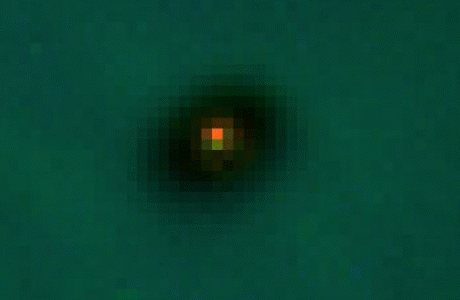- Three small bodies have been found in orbit
around the pulsar PSR 1257+12. They have been designated
"PSR1257+12 A, ..B, and ..C". One is about the size of the
Moon,
the other two are about 2 to 3 times the mass of Earth.
But, while the evidence for these is pretty
good, they aren't really what we're looking for when we talk about
'solar systems'.
- It has been known since 1983 that the star
Beta Pictoris is surrounded by a disk of gas and dust.
Though it's far from certain it is believed by some that planets
may already have formed around Beta Pictoris.

- The IRAS satellite found that Vega had too
much infrared emission, and that has been attributed to a dust
shell (with a mass of maybe Earth's moon).
- Observations of the very nearby Barnard's Star
were once thought to be evidence of gravitational effects of
planets but they now seem to have been in error.
- The star Gl229 seems to contain a 20 Jupiter
mass object orbiting at a distance of 44 AU. An object this large
is probably a brown-dwarf rather than an ordinary planet.
- What may be the first discovery of a planet
orbiting a normal, Sun-like star other than our own has been
announced by astronomers studying 51 Pegasi, a spectral
type G2-3 V main-sequence star 42 light-years from Earth.
These observations have now been confirmed by
several independent observers. And there is some evidence for a
second planet much farther out that is not yet
confirmed.
- On 1/17/96 Geoffrey
Marcy and Paul
Butler announced the discovery of
planets orbiting the stars 70 Virginis and 47 Ursae
Majoris. 70 Vir is a G5V (main sequence) star about 78
light-years from Earth; 47 UMa is a G0V star about 44 light-years
away. These were discovered using the same doppler shift technique
that found the planet orbiting 51 Pegasi.
The planet around 70 Vir orbits the star in an
eccentric, elongated orbit every 116 days and has a mass about
nine times that of Jupiter. Using standard formulas that balance
the sunlight absorbed and the heat radiated, Marcy and Butler
calculated the temperature of the planet at about 85 degrees
Celsius (185 degrees Fahrenheit), cool enough to permit water and
complex organic molecules to exist. The star 70 Vir is nearly
identical to the Sun, though several hundred degrees cooler and
perhaps three billion years older.
The planet around 47 UMa was discovered after
analysis of eight years of observations at Lick
Observatory. Its period is a little
over three years (1100 days), its mass about three times that of
Jupiter, and its orbital radius about twice the Earth's distance
from the Sun. This planet too probably has a region in its
atmosphere where the temperature would allow liquid
water.
- As of April 1996, Drs. Marcy and Butler have
discovered yet another planet this time around the star HR3522
(aka Rho 1 Cancri, 55 Cancri) about 45 light years from the
Earth. The planet is estimated to be about 0.8 Jupiter masses. It
is likely that several more planets will show up in the initial
set of 120 stars that they have monitored.
- Several more extra-solar planets have now been
discovered by the Butler/Marcy method. It seems likely that there
are a very large number of such planets out there.
- Detecting extra-solar planets directly is very
difficult. Even the Hubble
Space Telescope wouldn't be able to
image planets at the expected sizes and distances from their
suns.
What HST did find were disks of matter around
stars seen in  silhouette against the Orion Nebula (called 'proplyds', for
'proto-planetary disks' (right). This is great evidence for
how common these objects are, but the scale is way too small to
say anything directly about planets there. More detailed HST
images are now available, too.
silhouette against the Orion Nebula (called 'proplyds', for
'proto-planetary disks' (right). This is great evidence for
how common these objects are, but the scale is way too small to
say anything directly about planets there. More detailed HST
images are now available, too.

![]()
silhouette against the Orion Nebula (called 'proplyds', for
'proto-planetary disks' (right). This is great evidence for
how common these objects are, but the scale is way too small to
say anything directly about planets there. More detailed HST
images are now available, too.